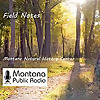
Field Notes from the Montana Natural History Center
108 FOLLOWERS
For keen observers, a walk to the grocery store or a hike up a mountain can inspire questions. Where do magpies nest? Why doesn't a spider stick to its own web? How do water striders keep from sinking? Every week since 1992, Field Notes has inquired about Montana's natural history. Produced by the Montana Natural History Center, Field Notes are written by naturalists, students and listeners..
Field Notes from the Montana Natural History Center
9M ago
In late 2020 I’m spending mornings masked, working in a lab in the University of Montana Zoological Museum. The museum houses research collections of natural artifacts like skins and skeletons. But behind the scenes museum staff tend a single living collection: a colony of dermestid beetles, the meticulous scavengers that scour flesh from bones before a skeleton can be installed in the museum ..read more
Field Notes from the Montana Natural History Center
9M ago
Why are they so feared and misunderstood? If a bird popularity contest were held, Turkey Vultures would not fare very well. A spooky bird contest, on the other hand? Dead winner ..read more
Field Notes from the Montana Natural History Center
10M ago
As I watched Rob Domenech, executive director of the Raptor View Research Institute, and his research biologist Brian Busby carefully load the three chicks onto the lift, and heard Harriet’s chirps of protest from above, I considered the importance of this work ..read more
Field Notes from the Montana Natural History Center
10M ago
At Lee Metcalf National Wildlife Refuge, I saw an Osprey dive into the deepest section of white water and emerge with nothing to show for its effort, and then retreat to a cottonwood branch to watch for another opportunity in the dark, boiling water ..read more
Field Notes from the Montana Natural History Center
11M ago
Despite the harsh and stark appearance, all is not lost after a wildfire. In fact, there is much to be found when you look about ..read more
Field Notes from the Montana Natural History Center
11M ago
Let me take you on a journey. It’s just a few miles, but over that short distance we’ll be transported not only to a dramatically different landscape, but also back through hundreds of millions of years of Earth’s history ..read more
Field Notes from the Montana Natural History Center
11M ago
The first sound we hear these early summer mornings is the prehistoric, other-worldly call of Sandhill Cranes. It rises deep from their impossibly long necks, climbs into the sky, and stretches for miles across the countryside ..read more
Field Notes from the Montana Natural History Center
1y ago
We’re wandering around the mostly evergreen woods nearby the ghost town of Garnet, Montana. we reach a sunlit clearing: a bright green patch with just a handful of trees ..read more
Field Notes from the Montana Natural History Center
1y ago
Usually, pronghorn will dash away when they see a truck coming. However, at times they race toward me, accelerating, seemingly intent on crossing the road ahead of me ..read more
Field Notes from the Montana Natural History Center
1y ago
My sister and I struggle to keep up with our mother. Today, we carry gallon-sized Ziploc bags, rolling the nearly-black berries from their stems to our palms to our bags ..read more